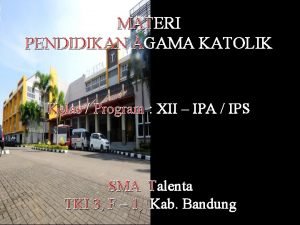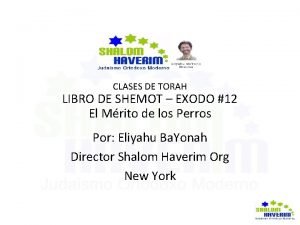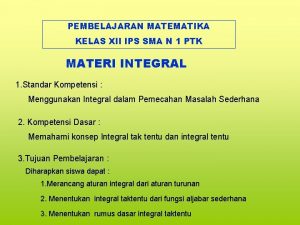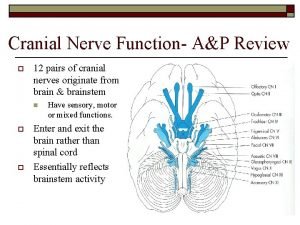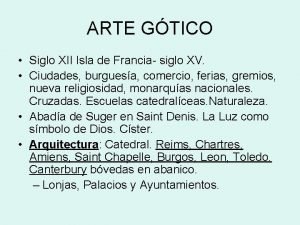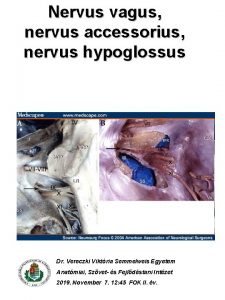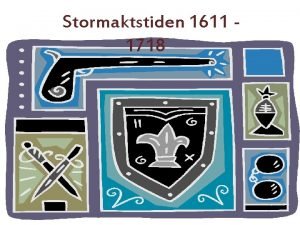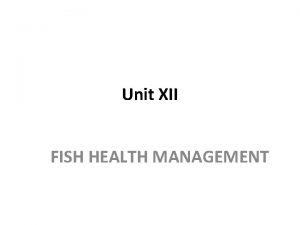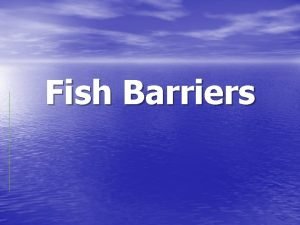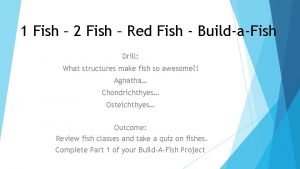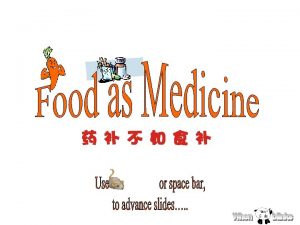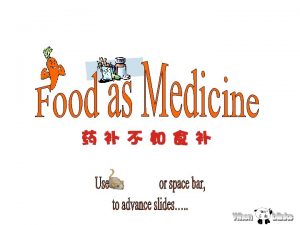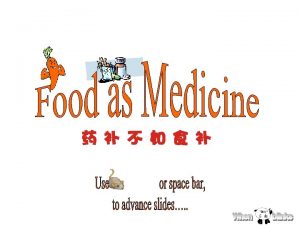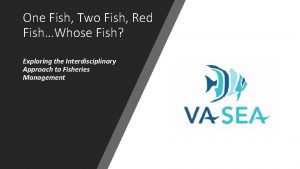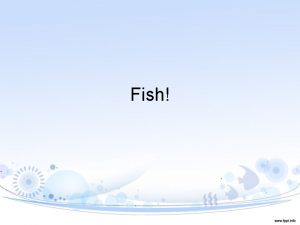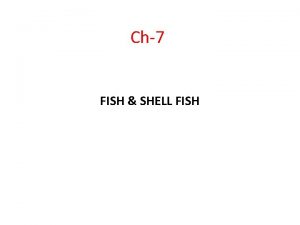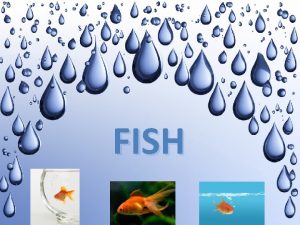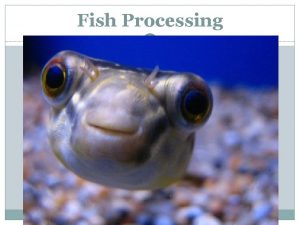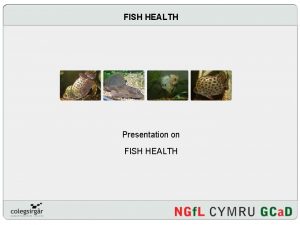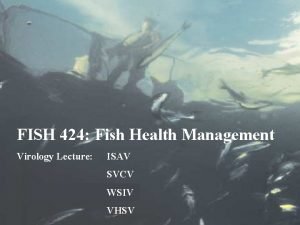Unit XII FISH HEALTH MANAGEMENT Fish health management


























- Slides: 26

Unit XII FISH HEALTH MANAGEMENT

Fish health management Introduction • A health management program and a disease emergency plan are essential documents on farms. As many farmers have recognized, the frequency and severity of disease outbreaks in ponds seem to depend on a number of factors • The first point to appreciate is that not all diseases are infectious. For example, some are caused by toxins, others by nutritional imbalances. • Infectious disease outbreaks in ponds depend on particular interactions between the host, the pathogen and the pond environment

Fish health management Principles of fish health management – Minimizing stress in cultivated fishes – Confinement of disease outbreak to affected ponds – Minimizing losses from disease outbreak.

Fish health management General preventive measures Increasing the internal resistance of fish is important in the prevention of diseases. • Selection of healthy fish seeds. • Proper density and rational culture. • Proper pond management • Qualitatively uniform ratio and quality food • Good water quality • Prevention of fish body from injury

Fish health management Common symptoms of diseases • • Unusual movements Abnormal and unhealthy look Discoloration Film like covering on the skin Swelling or spots on the skin Pale gills, white and red spot on gills Excess slime secretion

Fish health management Sources of infectious diseases • Primary source • Sick fish serves as a primary infectious source • The pathogen infects through direct contact or by discharge of disease causing agents into the water. • Secondary source • Water coming from diseased ponds, contaminated silt, feeds and gears.

Fish health management Natural resistance of fish to infectious diseases • Surface mucous membrane of fish Lysozyme secreted from the cell can kill bacteria. • Digestive enzymes which can kill pathogens. • The phagocytotic function of white blood cells, Lymphoid cells, reticulo-endothelial cells of spleen, liver and blood vessel can eliminate foreign body as well as pathogenic micro-organisms. • Blood of fish contains bactericidin which can eradicate all kinds of pathogenic bacteria.

Fish health management Type of diseases Parasitic Bacteria, fungi, protozoans, worms, leeches and copepods Non-parasitic Disorders associated with nutritional deficiency and sudden changes in abiotic and biotic factors Common symptoms are (a) Changes from normal behaviour, (b) Signs of reduced vitality, (c) Lack of appetite and failure to feed, (d) Presence of lesions or sores.

Fish health management BACTERIAL DISEASES Fin and tail rot Causative organisms: Aeromonas, Pseudomonas and Vibrio Symptoms: White line on the margin of the fin; fin rays become brittle and start breaking. Treatments: 1 minute dip treatment in 500 ppm copper sulphate solution.

Fish health management Dropsy Causative organisms: Pseudomonas punctata Symptoms: Accumulation of fluid inside the body cavity; scale protrusion; exophathalmic condition. Treatments: Dip treatment in 5 ppm potassium permanganate solution for 2 minutes.

Fish health management Eye disease Causative organisms: Aeromonas liquifaciens Symptoms: Cornea of eye becomes vascularised and later becomes opaque; eye ball gets decayed. Treatments: Chloromycetin (8 -10 mg/litre) bath for 1 hour for 2 -3 days.

Fish health management FUNGAL DISSEASES Water – mold disease (Saprolegniasis) Causative organisms: Saprolegnia parasitica Symptoms: Dies after ulceration or exfoliation of skin followed by haemorrhage, blindness, tufts of white hair like out-growth in the affected region. Treatments: Dip treatment for 3 seconds in 1: 10, 000 solution of malachite green or for 5 -10 minutes in 3% common salt solution or potassium permanganate.

PROTOZOANS Fish health management Ichthyophthiriasis (White-spot disease) Causative organisms: Ichthyophthirius multifilis Symptoms: Small whitish-cysts of about 1 mm diameter on the skin, gills and fins. Treatments: 5 days bathing in 2 ppm methylene blue, hourly dip treatment in 1: 5, 000 formalin solution for 7 -10 days. Ichthyophthirius multifilis

Boil disease Fish health management Causative organisms: Myxobolus pfeifferi Symptoms: Large boils varying from the size of a nut to that of a hen’s egg on several parts of body. Treatments: Bath in 3% common salt solution or in 1: 2, 500 formalin solution for 10 minutes.

Fish health management Whirling disease Causative organisms: Myxobolus cerebrails Symptoms: Caudal bend, deformity of the oral region and blackening of tail region. Treatments: Destroy all infected fish by applying quicklime (pond disinfectant) at the rate of 2 t/ha. Myxobolus cerebralis

Fish health management Costiasis Causative organisms: Costia necatrix Symptoms: Bluish-coating on the skin, lesions as irregular patches. Treatments: Bath in 3% common salt solution or in 1: 2, 500 formalin solution for 10 minutes.

Fish health management TREMATODES Gyrodactylosis Causative organisms: Gyrodactylus sp. Symptoms: Fading of colours, drooping of scales, peeling of skin. Treatments: Dip treatment in 5% common salt solution or in 1: 5, 000 formalin solution for 5 minutes.

Fish health management Dactylogyrosis Causative organisms: Dactylogyrus sp. Symptoms: Fading of colours, drooping of scales, peeling of skin. Treatments: Dip treatment in 5% common salt solution or in 1: 5, 000 formalin solution for 5 minutes.

Fish health management Diplostomiasis (Black-spot disease) Causative organisms: Diplostomulum sp. Symptoms: Small black nodules of about 1 -5 mm diameter in the affected region. Treatments: Dip treatment in 3: 1, 000 picric acid for 1 hour, Di-n-butyl tin oxide at the rate of 250 mg/kg fish.

CESTODES Fish health management Ligulosis Causative organisms: Ligula sp. Symptoms: Dull, sickly and with parts of alimentary canal swollen or completerly choked by cestode cysts or worms. Treatments: Dip treatment in 3: 1, 000 Picric acid for 1 hour, Di-n-butyl tin oxide at the rate of 250 mg/kg fish.

Fish health management NEMATODES Causative organisms: Philometra sp. , Camallanus sp. Symptoms: Dull, sickly and with parts of alimentary canal swollen or completerly choked by round worms. Treatments: Dip treatment in 3: 1, 000 Picric acid for 1 hour, Di-n-butyl tin oxide at the rate of 250 mg/kg fish.

Fish health management ACANTHOCEPHALA Causative organisms: Acanthogyrus sp. Symptoms: yellowish white fibro epithelioma on lip, skin and fin Treatments: Quick lime HIRUDINEA Causative organisms: Hemiclepsis sp. Symptoms: Abnormal movements of the fish due to irritation as the parasites feed on the blood of host. Treatments: Dip treatment in 1: 1, 000 solution of glacial acetic acid

Fish health management COPEPODS Disease : Causative organisms: Argulus sp. , Lernea sp. , Symptoms: Loss of scales and presence of red spots, damage of gills. Treatments: Half an hour treatment in 500 ppm formalin solution, mechanical removal by forceps followed by a bath in weak potassium permanganate solution for 2 -3 minutes, bath in 1: 1, 000 glacial acetic acid solution for 5 minutes and subsequent bath in 1% common salt solution for 1 hour, pond may be disinfected by applying Lindane at the rate of 8 ml/1, 000 litre Argulus Lernea

VIRAL DISEASES: Fish health management Disease : - Lymphocystis Causative organisms : Lymphocystis spp. (DNA Iridovirus). Symptoms: Lethargy, may affect balance and swimming Control if along the lateral line. Treatment : Frequent water changes and reduction of ammonia and nitrites in water may reduce stress to help the fish battle the infection and shrink tumors on its own.

Fish health management Disease: Infectious Pancreatic Necrosis-(IPN) Causative organisms: IPN virus Symptoms: Darker in color, tail chasing, spiral swimming behaviour Treatment: uncontaminated water supply, providing optimum feed

Fish health management Miscellaneous Diseases Gas bubble disease • When nitrogen of the water is in saturation • Gas bubble disease may result and fish fry particularly, die in large numbers. • Fish affected by this disease often swim at an angle of 45 o with head pointing down. • Other symptoms are the presence of bubbles beneath the skin, on fins, around eyes, in stomach and intestine or in blood capillaries
 One fish two fish red fish blue fish ride
One fish two fish red fish blue fish ride Twofish and blowfish
Twofish and blowfish Characteristics of fish
Characteristics of fish Xii lo im henryka sienkiewicza
Xii lo im henryka sienkiewicza Xii in numbers
Xii in numbers Materi agama katolik kelas xii semester 1
Materi agama katolik kelas xii semester 1 Shemot (éxodo) xii (22 - 27)
Shemot (éxodo) xii (22 - 27) Solas chapter xii
Solas chapter xii Ptk matematika sma kelas xii doc
Ptk matematika sma kelas xii doc Clemens 12 pont max
Clemens 12 pont max Fons omnis publici privatique iuris
Fons omnis publici privatique iuris Cranial nerve smiling
Cranial nerve smiling Francia siglo xii
Francia siglo xii Stalag allemagne
Stalag allemagne When i do count the clock
When i do count the clock Pope pius xii award
Pope pius xii award Materi kelas 12 semester 1
Materi kelas 12 semester 1 Xii lo toruń
Xii lo toruń Nervus vagus
Nervus vagus Col.legi pius xii
Col.legi pius xii Xii tablas
Xii tablas I centauri divina commedia
I centauri divina commedia Mitacin
Mitacin Ad altare dei
Ad altare dei Lecturas del domingo xvii del tiempo ordinario ciclo b
Lecturas del domingo xvii del tiempo ordinario ciclo b Xii domenica del tempo ordinario anno b
Xii domenica del tempo ordinario anno b Karl xii
Karl xii





